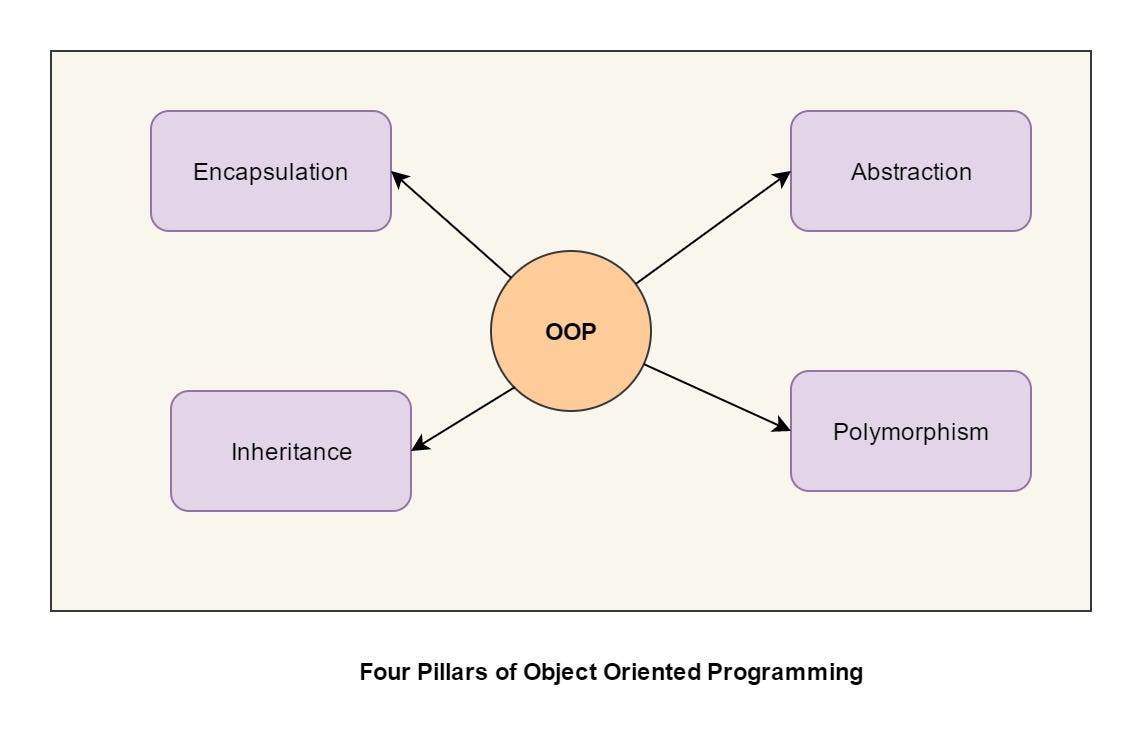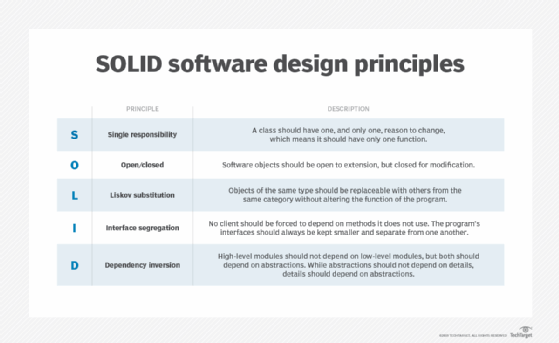A Solid Object-oriented Design Process Includes Which of the Following
Ii Objects may be distributed and may execute either sequentially or in parallel. Thankfully this acronym makes the five principles relatively easy to memorize.

What Are Four Basic Principles Of Object Oriented Programming By Munish Chandel Medium
The gathering requirement happens after the developing user interface prototype.

. A class should have a single responsibility. Object design includes the following phases. The class model shows the attributes and the behavior associated with the objects.
SOLID is an acronym for five object oriented design principles that make software understandable flexible and maintainable. A abstract specification 5. You can apply it to classes software components and microservices.
The following information was integrated from various sources on the Web. To follow this principle your class isnt allowed to have more than one responsibility eg the management of entities or the conversion of data types. Class Model State Model and Interaction Model.
For designing object-oriented software five principles have emerged over the years. The process of object-oriented analysis includes the following key steps ________. This concept is often used to hide the internal state representation of an object from the outside.
S RP -- Single Responsibility Principle. Develop detailed sequence diagrams for each use case. The class model shows all the classes present in the system.
Liskov Substitution Principle LSP Interface Segregation Principle ISP Dependency Injection or Inversion principle. The SOLID principles comprise of these five principles. Candidate objects can be found by looking at the verbs in a problem description.
Object-oriented design is like an alloy consisting of a solid grounding in the object-oriented OO approach and implementing the best OO practices heavily laced with how to sidestep the OO pitfalls. It describes the idea of wrapping data and the methods that work on data within one unit eg a class in Java. For example the domain model for a banking system contains classes like Account Branch.
Analysis design and implementation steps in any order and using the. Single Responsibility Principle SRP. A i ii and iii only.
C i-True ii-False iii-True 11. Single Responsibility Principle SRP Open Closed Design Principle. Several different processes have been identified for object oriented design.
Typically the design process involves considerable trial-and-error. Analysis design and implementation steps in the given order and using multiple iterations. A create a problem description find all the verbs in the description then create the classes.
GUIs are often built with a model-view architecture. Single Responsibility. Most non-object-oriented programming language provide if ifelse and case or switch statement forms as alternation constructions.
Object Oriented Analysis is a process through which you can identify the classes in your problem domain. Asked by Chetan Somavanshi According to the Indirection principle of the GRASP approach to object-oriented design how can you decouple multiple objects to better support reuse. The requirement document does not need to be very specific to represent the true nature.
B System structuring 9. O CP -- OpenClosed Principle. Object representation ie construction of design models.
Implementation of control for external interactions. These five principles help us understand the need for certain design patterns and software architecture in general. Asked by Anonymous Which of the following statements describes the Controller principle of the GRASP approach to object-oriented.
Analysis design and implementation steps in the given order and using the steps no more than one time. D The dependency inversion principle. It represents what the user wants the system to do and is the most important part of the system.
The SOLID Principles are five principles of Object-Oriented class design. Difference between controlled and uncontrolled rectifier. A client server model 12.
You get different code to execute by assigning a new object to the variable. State whether the following statements about the characteristics of an object-oriented design are True or False. The design process isnt only a matter of applying basic OO principles.
C function oriented design 4. Package classes and associations into modules. A Architectural design 8.
B object oriented design 3. B Visual notations 6. I System functionality is expressed in terms of operations or services associated with each object.
There are five specific aspects of object-oriented programming that each SOLID principle addresses with each letter representing one principle. So I believe that it is a topic that every. Optional Develop a set of CRC cards for each use case.
Object-oriented design is the process of finding and defining a useful set of functions for solving a problem. The SOLID principles of Object Oriented Design include following five principles. SOLID is one of the most popular sets of design principles in object-oriented software development introduced by Robert C.
Develop a first cut design class diagram. Yiğit Kemal Erinç. The interface segregation principle.
There are 3 types of models in the object oriented modeling and design are. They are a set of rules and best practices to follow while designing a class structure. CA001 The object-oriented development life cycle is which of the following.
A architectural design 2. C identify the private and public variables then prototype the functions and write the code. Send a message to a variable.
Do this with a first cut sequence diagram which focuses on the problem domain classes. Types of Models. Describe the object-oriented detailed design steps.
D True True 13. These principles are summarized by the acronym SOLID which stands for. A Graphical notations 7.
Most developers are well-aware of the concepts of object-oriented development but those same concepts originate from a broader approach to the entire software development life cycle known as object-oriented analysis and design OOADOOAD is a technical method of analyzing and designing an application based on that systems object models the logical. Martin popularly known as Uncle Bob. The Liskov substitution principle.
The level of detail needs to be very technical. In structured design data architectural user interface and procedural designs formed the design model describing how to implement the system. What are the SOLID principles of object-oriented design.
Encapsulation is one of the fundamental concepts in object-oriented programming OOP. E identify the needed classes define their attributes and behaviors. The first step of object design is object.
The single responsibility principle is one of the most commonly used design principles in object-oriented programming. These are explained as following below. In object-oriented languages there is another alternation construction.
One should go further and achieve a reasonable tradeoff between OO design. In this page we introduce the SOLID principles that is Single responsibility Open-closed Liskov substitution Interface segregation and Dependency inversion. C shared repository 10.

The Journey Around The Five Solid Software Design Principles Comes To End With This Article About The Dependenc Principles Software Development Software Design

10 Object Oriented Design Principles Java Programmer Should Know Principles Object Oriented Programming Open Source Code

What Is Solid Software Design Principles Definition From Whatis Com

Understand Object Oriented Programming Oops Concepts In Php Oops Concepts Object Oriented Programming Programing Knowledge
Comments
Post a Comment